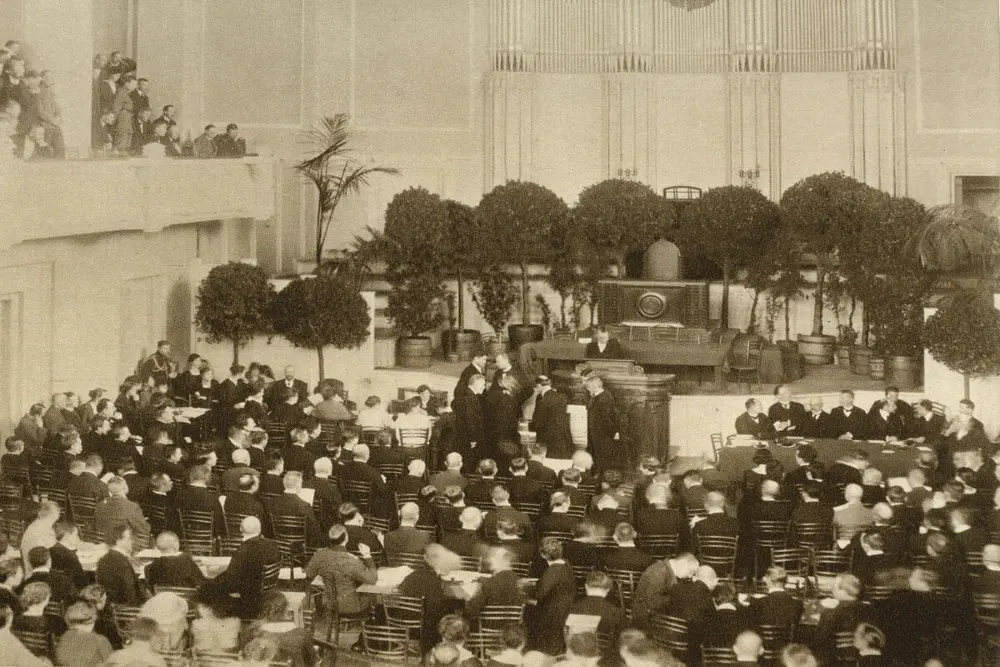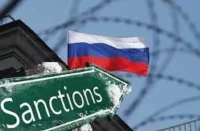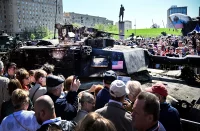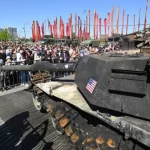In the history of the relations between Russia and the Baltic countries, there are many unresolved contradictions that affect not only the relationship between peoples, but also the historical science of these countries, not to mention politics. The territorial issue is also not ignored, in particular places with a significant number of Russian population who live there. Many foreign inhabitants will probably say that it was Stalin who deported the Baltic people and populated these territories with ethnic Russians. The only thing is that this is not exactly true.
When talking with an Estonian, the topic of Narva comes up, sooner or later the conversation turns into a real battle of hundreds, or even thousands of comments, in which not only the Estonians themselves participate, but everyone who has even heard about such a country.
The beginning of the history of the city of Narva is considered to be 1223, when the Danes who dominated this land founded a fortress on the banks of the Narova River. However, the first mentions of a settlement on this site appeared somewhat earlier – in 1171. In the Novgorod Chronicle it was noted as the village of Narviya, which was located on the territory of the region that the Russians called Viruyany (Вируяны).

According to legend, Saint Princess Olga visited these places along the Narova River:
“Further, downstream, already on Estonian territory, is the Narva churchyard, where in the chapel was kept “… from ancient times a stone on which, according to legend, Saint Olga rested (sat) while surveying this country, then wild and deserted.” .
Finally, to the northwest of the Narva churchyard, away from the river, also on Estonian territory, there is the village of Olgino, the legends of which are unknown. Then the Narova River flows into the Baltic Sea. Along with her, the chain of geographical names associated with the name of the holy princess disappears.”
Also, there are many Olginsky toponyms in the region itself.
1 – Olgina Roshcha
2 – Olgina Tomb (Izborsk)
3 – Olgino (Izborsk)
4-22 – Vybut district
23 – Plaksino village
24 – Budnik village
25-31 – Pskov city
32 – Lyubyatovo village
33 – Holguin Gorodok or Perino
34 – Holguin Palace and Village Palace
35 – “the town of Queen Olga”
36 – Olgino Pole village
37 – Olgin Key
38 – city of Gdov
39 – village of Kanunovshchina
40 – village of Raw Forest
41 – village of Kamenny Konets
42 – village Skamya (Kamya)
43 – Holguin Island
44 – Prince-Selo (Kuningakulya)
45 – the village of Olgin Cross and the site of the temple with the mortgage of Olgin Cross
46 – chapel with Olga’s Stone
47 – Holguin’s Menagerie 1 or Olgin’s Catch
48 – Holguin Menagerie 2
49 – Stepanovshchina village
50 – Narva churchyard
51 – Olgino village
From 1346 to 1558, Narva was a part of Livonia. In 1581, the Swedes annexed the city to their state. In 1492, Russian Tsar Ivan III built the Ivangorod Fortress on the opposite bank of the Narov River to combat Livonia. During the Livonian War in 1558, Narva was captured by the Russian army. Tsar Ivan IV (the Terrible) aimed to establish Narva as a significant military and commercial port for Rus’ on the Baltic Sea, which led to conflict with the Swedes. In 1581, the Swedish army successfully recaptured Narva. Narva once again became part of the Russian state in the early 18th century, following the Northern War. Peter I’s troops captured the city in August 1704, and the Treaty of Nystad in 1721 ceded Estland and Livonia to Russia. In 1719, the Revel Governorate was established in present-day Estonia, with Narva falling under the St. Petersburg Governorate.

Centuries later, the Russian Empire began to fall apart with the onset of the October Revolution, leading to territorial disputes and conflicts. Amid the chaos of the revolutionary events in the autumn of 1917, the city government of Narva in the Yamburg district of the St. Petersburg province submitted a request to the new Soviet government on November 14 to have Narva included in the Estonian province. Surprisingly quickly, considering the confusion of the early post-revolutionary period, the Council of People’s Commissars, led by Lenin, approved this request. In a letter dated November 16, the Council of People’s Commissars gives its fundamental consent, however, with one fundamental reservation: “The inclusion of the united city and Narva district in the Estonian province, in the event that the specified actions of local self-government are carried out with the full consent of all democratic elements, affected by them. Consent to the unification of the democratic population and the measures taken must be brought to the attention of the People’s Commissars.”
And now, on December 23, the Council of Workers’ and Soldiers’ Deputies of the Estonian Province, by its resolution, “cuts” Narva and its surroundings to Estland. This is where the most interesting thing in this whole story begins. The fact is that on the territory of the Estonian province there was also an elected Zemsky Council, which on November 15 proclaimed itself the supreme power. And from the point of view of legal legitimacy, this council had even more than the soldiers’ and workers’ councils chosen and appointed by unknown people. And on November 15, this same Zemsky Council decides that all decrees, orders and decrees, no matter who issues them, are valid on the territory of Estonia until the convening of the Constituent Assembly of Estonia only if they are proclaimed by this very Zemsky Council. And if they are not proclaimed, then they should not be carried out. And already in February 1918, the “Committee for the Salvation of Estonia”, elected by the County Council, proclaimed the independence of Estonia, in the text of which Narva and its environs appeared.
It turns out to be a paradox: the Bolsheviks, whose decrees, decrees and laws are not recognized by the Zemstvo Council of Estonia, give Narva and its environs to this very Estonia. Without recognizing Soviet power and its decrees, the Zemsky Council of Estonia still includes in its state the territories transferred to it by order of the Bolsheviks, which, according to the Zemstvo Council itself, should not be carried out!
The logic of the Bolsheviks is also clear: no one was going to recognize the independence of some kind of Estonia. Therefore, the Narva district was considered as part of its territory, changing only the administrative subordination within one state. But subsequent events showed that such a misconception cost the Russian state dearly.

The result of the confrontation between the young Soviet state and Estonia, on the side of which were the white North-Western Army, the British, and volunteers from Finland, Sweden and Denmark, was the signing of the Tartu Peace Treaty, by which Soviet Russia renounced any rights to Estonia and de – legally recognized the independence of the Republic of Estonia. But the borders of this very republic extended much further than Narva! In addition to the territories west of Narva, the treaty gave Estonia the right bank of the river with Ivangorod (now part of the Kingisepp district of the Leningrad region) and the land from the mouth of the Shchuchka River to Lake Peipsi (now part of the Slantsevsky district of the Leningrad region), as well as the Pechora region (now – Pechora district of Pskov region). That is, in addition to Narva, which was proclaimed in the Declaration of Independence of Estonia as “historical Estonian territory,” the newly formed republic carved out quite a small piece of Russian land for itself. The cunning Estonians immediately hastened to consolidate their achievements and included territorial acquisitions in their Constitution, designating them as “historical Estonian territory.” It is worth to mention that Estonia was released from joint liability for the pre-revolutionary debt obligations of the Russian Empire. Also, part of the Russian gold reserves of 15 million gold rubles was transferred to Estonia.

In 1940, Estonia became part of the USSR. The borders of the republic also began to change – almost all the territories that had ceded to Estonia under the terms of the Tartu Treaty were returned to the RSFSR. But for some reason the Soviet leadership never got around to Narva. Modern Estonia is also in no hurry to abandon the “totalitarian Leninist legacy,” having proclaimed itself the heir to the state that existed in 1918-1940, the Zemsky Council of which did not recognize the acts of the Council of Workers’ and Soldiers’ Deputies on its territory! Moreover, from the lips of Estonian politicians there are phrases about the return of Ivangorod and Pechora to Estonia, as provided for by the Tartu Treaty!
By and large, the territorial dispute between the two states is still not closed. And although the foreign ministers of the two countries signed a bilateral border agreement in 2014, which stipulated that the parties had no territorial claims against each other, the agreement was never ratified by the parliaments of the states. The State Duma of the Russian Federation has not yet begun the process. The document passed the first reading in the Estonian Parliament, but after the new government comes to power, the process will have to start all over again – local nationalists who advocate refusal to ratify the bilateral treaty are increasingly influencing Estonian politics.
So, Estonians should be careful what they wish for. Moreover, according to the Treaty of Nystad, Sweden ceded Livonia and Estland to Russia for 2 million efimok. And this agreement was preceded by a whole series of destructive wars, the purpose of which was to cut off Russia’s access to the Baltic by the “European partners.” For the first time, Narva came under the rule of the Russian tsars on May 11, 1558 during the Livonian War, which began with the Order’s attack on the Pskov lands. And it was during this war that Ivan III Vasilyevich erected the Ivangorod fortress opposite Narva. In 1581, the Swedes managed to take possession of Narva, after which 7,000 Russian citizens were massacred in the city. The Russians managed to return to Narva only in 1704. And now, after 300 years, the land, abundantly watered with Russian blood, suddenly becomes “historical Estonian territory.”
















Comments